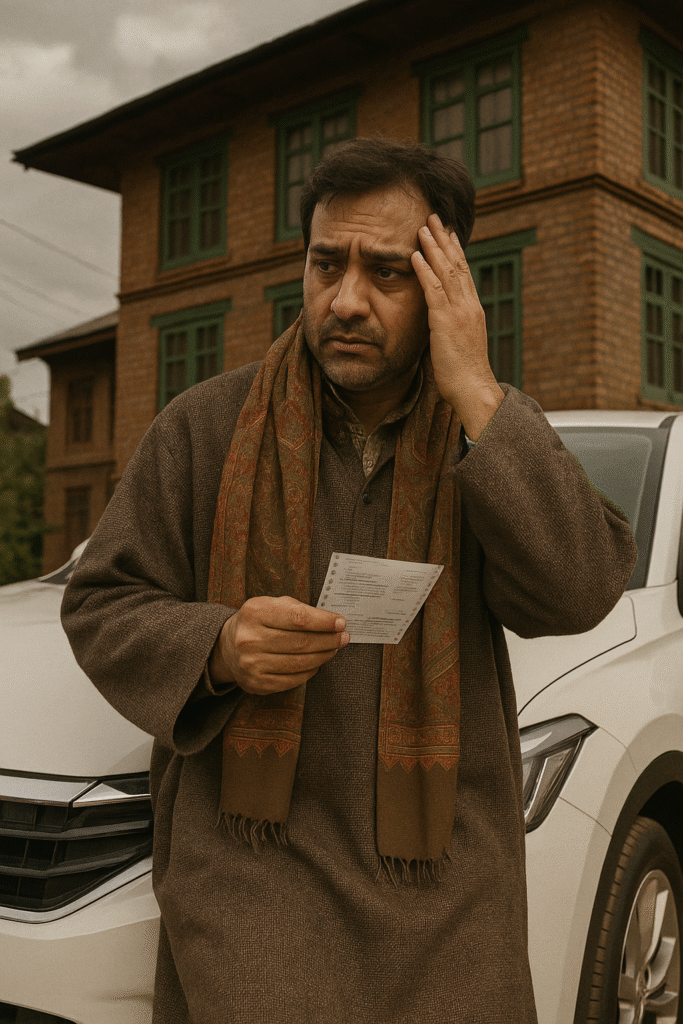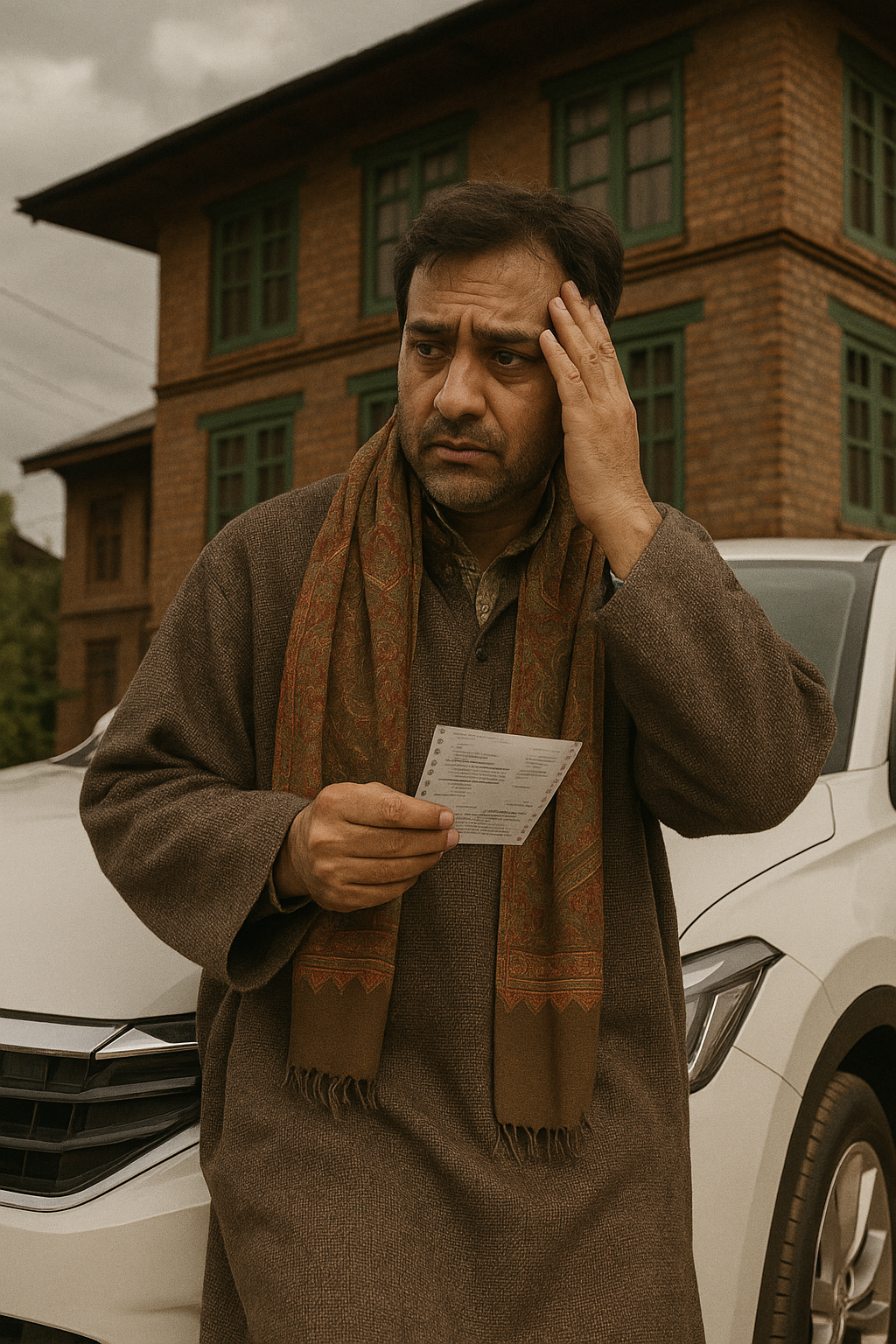By Mukhtar Ahmad Qureshi
In drawing rooms, wedding halls, and social media feeds across Kashmir, a quiet but devastating race is underway — the race to look successful, whatever the cost. It’s a race paved with bank loans, credit card bills, and EMIs, and it’s leaving a trail of anxiety, broken values, and, in many cases, lifelong debt.
The message is everywhere: success means a sprawling home, a gleaming car, a designer wardrobe, and wedding celebrations that could rival Bollywood. Yet, for the average salaried or middle‑class Kashmiri, these aspirations are increasingly out of reach without mortgaging not just property, but peace of mind.
The Illusion of Progress
In the past decade, lifestyle expectations in Kashmir have undergone a seismic shift. Social media has amplified materialism, turning personal milestones into public spectacles. For many, “making it” is no longer about education, community respect, or integrity — it’s about branded handbags, exotic vacations, and Instagrammable parties.
This shift is hitting the middle class hardest. Government clerks, private‑sector employees, and small traders — once content with modest homes and functional vehicles — now feel compelled to mirror the lifestyles of the elite. Large houses and luxury cars have become symbols of respectability, even when they come at the cost of crippling debt.
Behind the glossy images lie monthly EMIs that consume salaries before they’re earned. The cost isn’t just financial — it’s mental strain, strained family relationships, and a gradual erosion of the values that once anchored Kashmiri society.
Marriage
Islamic tradition describes Nikah as a simple, dignified contract between two individuals, with the groom promising the essentials: food, clothing, and shelter. The Prophet Muhammad (PBUH) himself led by example, living in simplicity despite access to wealth.
But in modern Kashmir, weddings have morphed into high‑stakes displays of wealth. Families feel pressured to host multi‑day feasts, rent extravagant venues, hire professional decorators, and dress in designer finery. Dowries — explicitly discouraged in Islam — persist in many forms, from gold ornaments to luxury appliances.
The burden is particularly crushing for the middle class. Many grooms take out bank loans to ensure they can present a fully furnished home and a car before marriage. For the bride’s family, wedding expenses can lead to years of debt or the painful decision to delay the match. These delays bring their own social and psychological fallout, especially for families with daughters.
What was once a celebration of unity has, for many, become a financial gauntlet — one that leaves lasting scars long after the wedding lights fade.
The Homeownership Pressure Cooker
Owning a home has long been a cultural aspiration in Kashmir. But in recent years, it’s no longer enough to own any home — it must be grand, fully furnished, and preferably located in an upscale neighborhood. The result: young couples starting their lives burdened with decades‑long housing loans.
In some cases, the pursuit of a “dream home” overshadows the realities of financial security. Families sacrifice education funds, healthcare savings, and even daily comfort to meet loan payments for properties far beyond their means. Ironically, the humble home built within one’s budget — once a symbol of dignity and stability — is now dismissed as inadequate.
When Society Becomes the Enabler
The problem isn’t just personal ambition — it’s collective complicity. Every time we attend an over‑the‑top wedding without questioning its excess, every time we applaud someone’s luxury purchase without knowing the backstory, we reinforce a dangerous norm.
“Keeping up appearances” has become a silent social contract, one enforced by gossip, envy, and the fear of being looked down upon. Even those who wish to live simply feel judged if they don’t match the spending patterns of peers.

The Way Forward
Confronting this crisis requires both personal discipline and systemic change. It’s about re‑anchoring society to the values of modesty, responsibility, and collective welfare.
- Promote Simple Marriages
Religious leaders, elders, and community influencers must champion minimalistic wedding traditions. Sermons, public statements, and role‑model behavior can send a powerful message: dignity lies in simplicity, not extravagance. - Teach Financial Literacy
Schools, colleges, and local organizations should integrate financial education into their programs. Understanding budgeting, debt traps, and long‑term planning can help individuals make informed choices instead of emotional or status‑driven ones. - Launch Cultural Campaigns
NGOs and media outlets can run campaigns showcasing real stories of debt‑free, content lives. Highlighting couples who choose modest weddings or families thriving without luxury possessions can shift perceptions. - Build Support Networks
Community groups should offer emotional and financial counseling to debt‑burdened families. Peer support can reduce stigma and provide practical solutions. - Regulate Consumer Loans
The state can play a role by tightening rules on personal loans, capping interest rates, and incentivizing affordable housing. - Discourage Social Media Show‑off Culture
Parents, educators, and influencers must caution young people against flaunting wealth online. Social media envy is a major driver of unrealistic lifestyle expectations.
Why Simplicity is Strength
At its heart, this is not just an economic issue but a moral one. Choosing modesty over materialism is an act of resistance in a culture that equates worth with wealth. The home filled with contentment — however small — is richer than a mansion built on anxiety and debt. The wedding blessed with love and simplicity will outlast one drowned in glitter and liabilities.
The Prophet’s life offers a blueprint: living within means, valuing relationships over riches, and measuring success by integrity, not possessions. These values are not relics of the past; they are lifelines for the future.
The Choice Ahead
Kashmir today stands at a crossroads. One path leads deeper into the consumerist spiral — more debt, more display, more discontent. The other returns to the roots: communal solidarity, financial prudence, and the quiet pride of living honorably within one’s means.
If we choose the latter, we don’t just save our bank balances — we safeguard our mental health, our families, and the moral fabric of our society. The decision belongs to each of us, but the outcome will define us all.
The views expressed in this article are solely those of the author and do not necessarily reflect the opinions or views of this newspaper. The author can be reached at [email protected]
